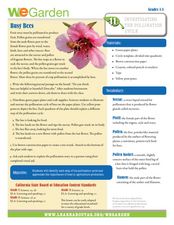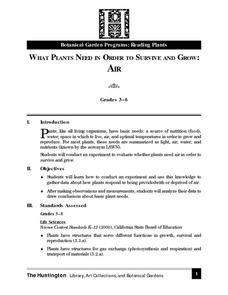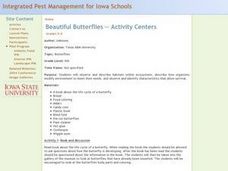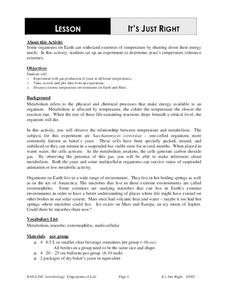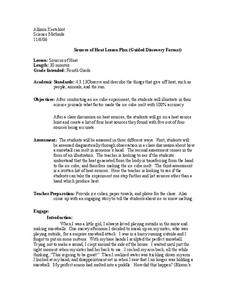Curated OER
Mission 3: Electrical Safety
In these recognizing electrical safety in the kitchen, bathroom, living room, outdoors, and in a storm worksheets, students read for information, identify electrical appliances, types of light switches, list possible dangers for each...
Curated OER
Anatomy and Physiology "Quickies"
Young scholars use a variety of creative writing tools within this assignment: poems on particular organ systems, write a short story and/or create a word graph. They are involved in a demonstration of lactic build up in the muscles, a...
Curated OER
Ecological Footprint
Eighth graders discover their own ecological footprint and create a plan for reducing this figure. They extend this to the school and community to see how they are doing on this scale. They discuss the concept of the ecological...
Curated OER
Adaptations of Fishes for Survival in Polar Environments
Students compare the anatomy of temperature and polar fishes. They explore the adverse effects of cold on metabolism and physiology and discuss how polar fishes adapt to their environments. Comparisons are also made to the DNA sequences...
Curated OER
Applied Science - Physics Pre-Lab
Learners observe fluid motion. In this Physics lesson, students explore the principles of Pascal, Archimedes, and Bernoulli. Learners list their experiences with fluid movement.
Aquarium of the Pacific
Turn a Cow into a Whale
Third graders explore animals that might have a common ancestor and resemble one another. For this cow and whale lesson, 3rd graders recognize the similarities between the whale and the cow. Students complete worksheets based...
Curated OER
The Energy Debate - Energy of Peanut
Students articulate the difference between the terms heat and temperature. They calculate the amount of energy associated with a given temperature rise and design an experiment to measure the energy of a fuel.
Curated OER
Hot n' Cold
Students keep a weather log. In this weather and temperature lesson, students discuss the information that can be obtained from a map and lead into a discussion about temperature. Students watch a video about temperature and...
Curated OER
Busy Bees
Students explore the pollination cycle. In this pollination lesson plan, students investigate the process of pollination. Students illustrate the pollination cycle of bees on paper plates.
Curated OER
Freshwater Habitats
Middle schoolers take samples from local freshwater sources and examine them for macroinvertebrate life. They take samples from both shallow and deep freshwater environments, measure temperatures, and classify organisms found in their...
Curated OER
What Plants Need in Order to Survive and Grow: Air
Students conduct an experiment to determine whether plants need air in order to survive and grow. They discuss natural resources, analyze slides, and observe and record data from the experiment.
Curated OER
I Know What I Am... but, What Are You? (Classifying Living Things)
Learners examine how to classify living things by effects, environment, and activity. They explore various websites, develop a list of facts they learn about classifications, and participate in a distance online learning session with the...
Curated OER
Photosynthesis: Using the Sun to Make Food
For this photosynthesis worksheet, students learn how plants use the sun to convert energy into food. They then answer 10 questions using the information they just read. The answers are on the last page.
Curated OER
Beautiful Butterflies - Activity Centers
Students describe habitats within ecosystems, describe how organisms modify environment to meet their needs, and identify characteristics for butterfly survival. In this butterfly lesson plan, students explore all aspects of the...
Curated OER
Building A Bug Bungalow
Students chart how milkweed bugs grow and change. In this growth and life stages lesson, students read two stories and discuss how and why things grow. Students brainstorm what can be measured about humans, review and discuss...
Curated OER
It's Just Right
Learners conduct an experiment to determine the temperature tolerance of yeasts. In this biology lesson, students collect data and compare them by plotting graphs. They explain how extreme temperatures affect organisms.
Curated OER
Mollusks
In this mollusks worksheet, students color several figures and label them with the correct parts. They complete 14 short answer questions related to mollusks.
Curated OER
Exploring Meteorite Mysteries: Building Blocks of Planets
Students simulate the formation of chondrites and asteroids. In this astronomy lesson, students demonstrate accretion using balloons and static electricity. They compare and contrast their models to the actual process of chondrites and...
Curated OER
Reading in the Content Area-Leeches
Learners practice the habits of good readers in the content area of science. While reading a brief article about leeches, they compare and contrast the material read with other information they have encountered.
Curated OER
Clay Ants: Insect Anatomy
Students examine anatomic structures in order to identify insects from other living organisms. They gain a level of comfort from anxiety when observing and handling live and pinned insects. They create clay models of an insect.
Curated OER
Health Issues Related to Space Experiments
Learners participate in a science lesson plan that integrates connections between health issues on Earth and how those issues are related to studies conducted on the International Space Station. T
Curated OER
Creepy, Crawly Critters
Students study characteristics of insects by creating models from an assortment of materials. They create rubrics showing what an insect must have and create an insect, using a bag of materials. They cut out the puzzle insects included...
Curated OER
Galileo: His Times & Beliefs
Students study Galileo and his scientific discoveries. They complete a series of experiments/model constructions, using 17th century equipment and procedures, to "recreate," demonstrate and explore the various discoveries of Galileo.
Curated OER
Sources of Heat
Fourth graders conduct an experiment related to heat sources, and participate in a heat source hunt. They identify sources of heat, then compare the melting rate of ice cubes, illustrating the results in their science journal. Students...










